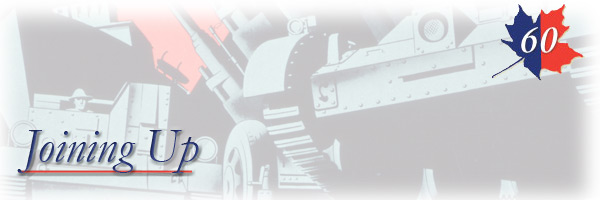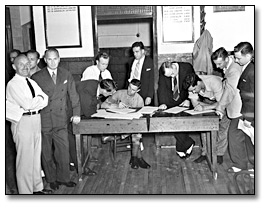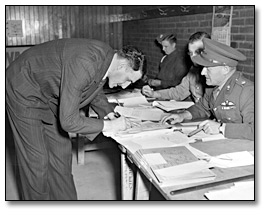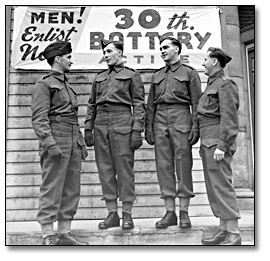
Table of Contents
Home | Joining Up | Military Training in OntarioWartime Production | Fund raising and Volunteerism | Sources and Additional Information
From the fall of France in June of 1940 until the German invasion of the Soviet Union in June 1941, Canada was Britain’s largest ally in the war with Germany. With the hurried evacuation of the British Expeditionary Force from Dunkirk, the British were forced to leave behind their military equipment and weapons. This left a Canadian division in Britain as one of the few equipped and intact units in place to defend the country.
At the same time, a secure location was needed to train the pilots and aircrews that would defend Britain. This placed a huge burden on Canada as it sought to raise as many troops as possible and move them across the Atlantic.
With the entry of the Soviet Union and the United States into the war the emphasis moved from raising troops to defend Britain to creating an army to participate in the planned invasion of Europe.
This part of the exhibit illustrates Ontario’s participation in the recruitment of a Canadian army.

![Photo: Special review day at Ontario Agricultural College [ca. 1939-1946]](pics/17212_review_day_270.jpg)
Click to see a larger image (109K)
Special review day at Ontario Agricultural
College [ca. 1940]
Black and white negative
Reference Code: RG 16-276-10
Archives of Ontario, I0017212
At its height in 1944 more than 750,000 Canadians were serving in the armed forces.
Of these, 481,000 served in the army, 206,000 in the air force and 75,000 in the navy. All this from a total population of 11 million in the whole of Canada.
Conn Smythe, the president of Maple Leaf Gardens, served as an officer during the Second World War and loaned the use of his facility as an enlistment centre.
Other sports celebrities lent themselves to promotional
activities in favour of enlistment, such as the Toronto Telegram’s
Sports writer Ted Reeve. The 30th Light Anti-Aircraft Battery
in the Canadian Army, led by Conn Smythe, was unofficially called
the Sportsmens' Battery.

Click to see a larger image (103K)
Military - World War II -
Enlisting at Maple Leaf Gardens (1939-1941)
Photographer unknown
Black and white print
Conn Smythe fonds
Reference Code: F 223-1-1-12
Archives of Ontario, I0016694

Click to see a larger image (88K)
Military - World War II - Enlisting at Maple Leaf Gardens (1939-1941)
Black and white print
Conn Smythe fonds
Reference Code: F 223-1-1-12
Archives of Ontario, I0016695
![Photo: Soldiers in mess hall, [ca. 1940]](pics/8962_men_in_mess_270.jpg)
Click to see a larger image (105K)
Soldiers in mess hall, [ca. 1940]
Herbert Nott fonds
Black and white negative
Reference Code: C 109-2-0-18
Archives of Ontario, I0008962

Click to see a larger image (114K)
Military - World War II - 30th L.A.A. (Sportsmen) Battery - Enlistment March (October 1941),
Conn Smythe fonds
Black and white print
Reference Code: F 223-1-1-13
Archives of Ontario, I0016698
![Photo: Inspecting new enlistees at Maple Leaf Gardens, [ca. 1939]](pics/16697_inspection_270.jpg)
Click to see a larger image (91K)
Military - World War II - Enlisting at Maple Leaf Gardens (1939-1941),
Conn Smythe fonds
Black and white print
Reference Code: F 223-1-1-12
Archives of Ontario, I0016697
![Photo: Inspecting new enlistees at Maple Leaf Gardens, [ca. 1939] (2)](pics/16696_inspection_wa_270.jpg)
Click to see a larger image (103K)
Military - World War II - Enlisting at Maple Leaf Gardens (1939-1941),
Black and white print
Conn Smythe fonds
Reference Code: F 223-1-1-12
Archives of Ontario, I0016696

Like the industrial workforce, the participation of women in
the armed forces increased exponentially over the course of the
war. In 1939 140 women were in uniform. By 1944 this had risen
to nearly 36,000.
During the First World War most women served as nurses, with few enlisting in other branches of the armed forces. In the Second World War, women assumed many of the non-combat roles previously filled by men including serving as pilots, drivers and clerks in Canada and Great Britain.
[Pte. Helen Mary Elizabeth Smith],
Member of the Canadian Women's Army Corps (C.W.A.C.) getting into a military vehicle,
Trinity Barracks, Toronto, Ontario. [ca. 1945]
Gordon W. Powley fonds
Black and White negative
Reference Code: C 5-1-0-80-3
Archives of Ontario, I0011205
![Photo: Military personnel in an army vehicle, [ca. 1945]](pics/11108_wacs_in_jeep_270.jpg)
Click to see a larger image (98K)
Military personnel in an army vehicle. [ca. 1945]
Gordon W. Powley fonds
Black and white negative
Reference Code: C 5-1-0-61-8
Archives of Ontario, I0011108
![Photo: Female miltary personnel working in an office, [ca. 1945]](pics/11103_wacs_typing_270.jpg)
Click to see a larger image (88K)
Female miltary personnel working in an office [on an army train?],
Peterborough, Ontario. [ca. 1945]
Gordon W. Powley fonds
Black and white negative
Reference Code: C 5-1-0-61-2
Archives of Ontario, I0011103
![Photo: Members of the Canadian Women's Army Corps (C.W.A.C.) reading magazines in a lounge in the Trinity Barracks, [ca. 1945]](pics/11208_4_cwacs_270.jpg)
Click to see a larger image (260K)
Members of the Canadian Women's Army Corps
(C.W.A.C.) reading magazines in a lounge in
the Trinity Barracks, [ca. 1945]
Gordon W. Powley fonds
Black and White negative
Reference Code: C 5-1-0-80-7
Archives of Ontario, I0011208
![Photo: Women in military uniform, [ca. 1945]](pics/11126_3_women_soldiers_270.jpg)
Click to see a larger image (96K)
Women in military uniform, [ca. 1945]
Gordon W. Powley fonds
Black and white negative
Reference Code: C 5-1-0-65-1
Archives of Ontario, I0011126
![Photo: Member of the Canadian Women's Army Corps (C.W.A.C.), Trinity Barracks, [ca. 1945]](pics/11205_cwac_near_car_270.jpg)